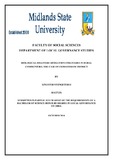Please use this identifier to cite or link to this item:
https://cris.library.msu.ac.zw//handle/11408/2888Full metadata record
| DC Field | Value | Language |
|---|---|---|
| dc.contributor.author | Nyengeterai, Linaster | - |
| dc.date.accessioned | 2017-09-21T20:10:00Z | - |
| dc.date.available | 2017-09-21T20:10:00Z | - |
| dc.date.issued | 2014 | - |
| dc.identifier.uri | http://hdl.handle.net/11408/2888 | - |
| dc.description.abstract | The study is entitled “Biological disasters mitigation strategies in rural communities. The case of Chimanimani district.” Biological disasters are impacting negatively on nations and communities. Chimanimani district is at risk of biological hazards among other districts in Zimbabwe. Various organisations in the district which constitute the District Risk Reduction Committee sought out ways to limit the incidences of biological disasters through mitigation approaches. However, there are challenges that are being faced by the DRRC and the community to lessen the impact of these disasters on communities. Chapter one is the roadmap of the study which start by revealing the background of the study globally, regionally, nationally and locally in Chimanimani. The objectives of the study were to assert the main causes of biological disasters in Chimanimani district, to assess the effectiveness of the mitigation strategies to curb the impact of disasters in the district, to identify the challenges that are being faced in lessening the impact of biological disasters , to suggest possible solutions and recommend to the Disaster Risk Reduction Committee on the measures that can be employed to ensure effectiveness of the mitigation strategies that are in place. Chapter two brought to light the views of different scholars, defines key terms, reveals the causes of biological disasters in general and the challenges that are being faced in reducing the incidences of disasters, these are economic meltdown, inadequate resources, dependency syndrome, little community participation and decision making, lack of data base, weak co-ordination on activities among stakeholders, lack of clear cut policies, lack of capacity to limit the impact of hazards. It also shows the solutions to the challenges as proposed by other scholars. Chapter three reveals research methodology where different sampling techniques such as judgmental sampling, simple random and snowball sampling techniques were used. The research was targeted at one hundred at fifty eight participants from the District Risk Reduction Committee and the community members. To collect data the researcher used research tools which include questionnaires, interviews and focus group discussions. Chapter four presented, interpreted and analysed data gathered from the field through questionnaires, interviews and focus group discussions. The findings in chapter four helps to draw conclusions and recommendations in chapter five. The conclusions are that, lack of human, financial and material resources can hinder effectiveness of disaster mitigation measures, if communities are not fully engaged in disaster risk reduction activities, disaster reduction measures will not be effective. Less Civil Protection meetings can hinder effectiveness of biological disaster mitigation approaches. The researcher recommended that, the district should enhance community participation and involvement, revive district risk reduction structures, ensure effective resource mobilisation, strengthen co-ordination among various government ministries, enhance training and ensure effective education to all health workers, partnership with the private sector and inclusion of the local institutions in the national budgets to curb the impact of lack of resources. Thus, there is need for the district to implement the proposed solutions so as to ensure effectiveness of biological disaster mitigation strategies. | en_US |
| dc.language.iso | en | en_US |
| dc.publisher | Midlands State University | en_US |
| dc.subject | Biological disaster mitigation strategies | en_US |
| dc.subject | Rural communities | en_US |
| dc.subject | Biological hazards | en_US |
| dc.title | Biological disasters mitigation strategies in rural communities: the case of Chimanimani district | en_US |
| item.languageiso639-1 | en | - |
| item.grantfulltext | open | - |
| item.fulltext | With Fulltext | - |
| Appears in Collections: | Bsc Local Governance Studies Honours Degree | |
Files in This Item:
| File | Description | Size | Format | |
|---|---|---|---|---|
| Lee final dess.pdf | Full Text | 1.43 MB | Adobe PDF |  View/Open |
Page view(s)
128
checked on Apr 13, 2025
Download(s)
108
checked on Apr 13, 2025
Google ScholarTM
Check
Items in MSUIR are protected by copyright, with all rights reserved, unless otherwise indicated.



